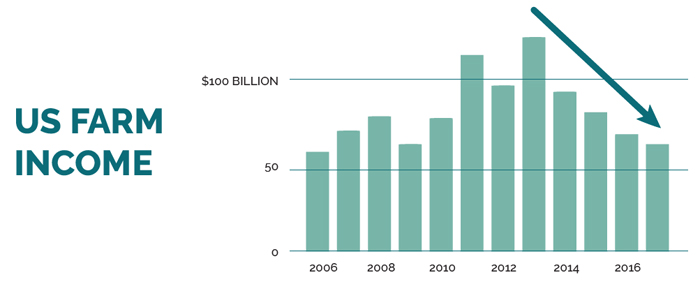The recent ag headlines don’t paint a pretty picture for farmers.
“Corn prices hovering at 10-year lows.” “Corn carryover threatening to break 30-year highs.”
“Interest rates and farm debts rising.” “Farm profits falling.”
“Farm bankruptcies up.” “Farm investments down.”
For some, the news reminds them a bit too much of the late 1970s and early 80s, just before the ag industry fell into its worst six-year stretch since the Great Depression.
Jim Miller, a farmer and longtime ag policy consultant, has closely followed and sometimes helped lead U.S. policies on agriculture, energy and trade for more than 40 years.
He was farming during that 1980s ag crisis. He was helping craft policy soon after it.
Miller grew up on and eventually ran his family’s centuryold farm in Washington state before getting more involved in lobbying efforts and moving to the other Washington — D.C. — to serve as vice president for government affairs at the National Association of Wheat Growers. He served a two-year stint as Under Secretary for Farm and Agricultural Services, held a senior position for the National Farmers Union, and has spent the last five years as the Vice President and Chief Economist for Growth Energy.
Today, Miller is still watching those headlines and pushing for policy changes from Arizona, where he runs Agriculture and Biofuel Policy Consulting (ABPC), a company he started in 2017.
In this interview for Vital magazine, Miller discusses biofuels’ ability to lift agriculture out of a crisis, the importance of value-added products, and the anticipated uptick in grain and ethanol demand from year-round E15.
Vital: Can you, in a few words, characterize the current state of the ag economy?
Miller: Pretty poor. That’s primarily due to declining commodity prices, especially for major grains such as corn, wheat and soybeans.
Vital: So, are we in the middle of a farm crisis?
Miller: I don’t know that I would characterize it as a crisis at the moment. But if these commodity prices continue to be depressed and we continue to see a fairly significant uptick in the number of farmers declaring bankruptcy, we could be entering a crisis.
Vital: Secretary of Agriculture Sonny Perdue recently said conditions today mirror the early ‘80s: ever-increasing yields, falling profits, rising interest rates. Do those comparisons scare you?
Miller: Well, they can. The domestic market for major agricultural commodities is pretty well saturated. A lot of what we need centers on international trade. What we really have to do is find new demand for corn around the world, especially if we’re going to continue to have the kinds of productivity increases that we’re witnessing.
Vital: The United States Department of Agriculture (USDA) is predicting nearly 2 billion bushels of corn carryout (or “ending stocks”). How do we work through that huge corn inventory?
Miller: I think everyone in the industry is looking at, “Okay, how do we process this corn into other products?” One key element is the bioethanol industry. That is our best opportunity to increase demand for corn. We need to increase the production of ethanol and find good markets both at home and around the world. If we can do that, we can work our way through this.
Vital: OK. So why isn’t the answer just to export more corn?
Miller: History has shown that we just don’t see huge changes in the amount of demand for number two yellow corn around the world. We really haven’t seen any sort of a major shift in the export demand for yellow corn in decades.
Vital: Is there a history of biofuels helping pull ag out of this kind of crisis?
Miller: Yes. Historically, biofuels have done that repeatedly. If one looks back over the past 10 to 20 years, and especially from the time that the U.S. passed its Renewable Fuel Standard, you see the ethanol industry has continued to figure out new and better ways to export this excess corn. And now the industry utilizes about 5.6 billion bushels of corn to produce ethanol as well as coproducts such as distillers grains. The real change in the demand for corn has come from the ethanol industry over the last decade or so. And there are opportunities for that demand to continue to grow.
Vital: How will it grow?
Miller: That demand will grow through higher ethanol blend grades in the United States and through rapid increases in the amount of ethanol being demanded in many overseas markets. It’s going to be that demand for ethanol that will help turn this boat around.
Vital: The EPA has announced a proposed rule that allows retailers to sell E15 yearround, including summer. Is that one of those steps in the right direction?
Miller: Oh, it certainly is. Allowing E15 to be marketed year-round will result in a significant increase in the number of retailers that begin to offer E15. That’s a big step to introduce more ethanol into the market.
Vital: What are some of the things that let you sleep at night?
Miller: Well, I’m optimistic that our trade relationship with China, particularly in the areas of agriculture and energy, can get resolved in a way that’s favorable to the United States. That is a huge — albeit, almost always uncertain — market, but it portends opportunities for a significant part of U.S. agriculture. … And we’ve got one country that could really be a game changer, and that is India. It’s the world’s largest democracy, second most populous country, has a rising middle class, huge environmental air quality problems. But they’ve also had a very protectionist policy. Growth Energy, the Renewable Fuels Association and the U.S. Grains Council continue to work very hard in India to get a policy that would encourage increased ethanol production. Selling biofuels into these new markets could make a big difference in helping the farm industry by moving that excess corn.
Vital: You’ve been doing this for a long time. Is this still exciting for you?
Miller: Oh, yes. Agriculture — and especially the bioethanol industry — are both extraordinarily exciting. There are going to be even more opportunities in agriculture. Bioethanol has changed the game in the last decade when it comes to new markets for corn around the world, and that has certainly kept things exciting in the industry.
Vital: Can biofuels be a game changer when it comes to turning the current ag economy around?
Miller: Definitely. Biofuels is certainly the leader in the kinds of new products, like distillers grains and corn oil, we can and need to export. We have so many uses for biofuels now. The growth in demand as well as the increased global interest in ethanol bodes well for us. Biofuels continue to lead in terms of helping create the demand for corn that our farmers need so badly. We know biofuels can help turn this thing around. We just need some help to make that happen.








